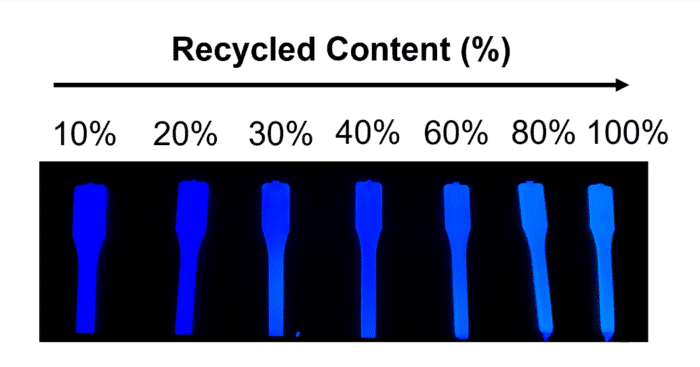How to tell if that plastic bottle or bag has recycled material in it
Advertisement
To encourage more recycling, the U.K. taxes single-use plastic products containing less than 30% recycled material. But aside from a manufacturer’s word, there isn’t an easy way to verify this composition. Now, researchers reporting in ACS Sustainable Chemistry & Engineering have developed a simple, fraud-resistant technique to evaluate the recycled content of new plastic products. They added a fluorescent tag to plastic resins, successfully tracking their amount in products made with various polymers and colors.

Adding a fluorescent tag to recycled plastics could help track their amount in new single-use products.
Adapted from ACS Sustainable Chemistry & Engineering 2022
After reducing and reusing, recycling is the last line of defense for keeping plastic out of landfills or the environment. And now, some countries are putting financial pressure on manufacturers so they get with the program. Whereas the U.K. is taxing plastic products with little recycled content, other countries, such as Italy and Spain, plan to impose taxes soon on products that contain no recycled content.
Approaches to verify these amounts aren’t always accurate, potentially leading to fraud and public mistrust. One solution could be to tag recycled polymers with the fluorescent molecule 4,4,-bis(2-benzoxazolyl) stilbene (BBS), and then track the tagged plastic feedstocks into resulting products. BBS’s fluorescence intensity and color vary when different levels are present. It’s also inexpensive and approved for food contact applications. So, Michael Shaver and colleagues wanted to see how BBS could be used to measure the recycled content of single-use products.
The researchers mixed small amounts of BBS into melted high-density polyethylene (HDPE) and then mixed that with virgin HDPE resin, simulating 0 to 100% recycled-content materials. As the amount of BBS-tagged HDPE rose in the samples, the fluorescence intensity shifted toward a greener hue of blue under a fluorescent light. The marked polymer had unique fluorescence properties, which the researchers suggest would be hard for someone with fraudulent intentions to replicate. Next, the team developed a simple digital image analysis technique that converted the material’s fluorescence into the percentage of recycled content. In tests, the method could identify the recycled content in other real-world polymers, including recycled milk bottles with additives, colored HDPE, polypropylene and poly(ethylene terephthalate). The BBS strategy could be applied to a variety of single-use plastic products without impacting their appearance or quality, the researchers say.
The authors have filed a patent on this technology in the U.K.
































































